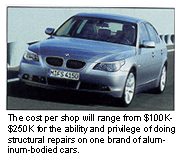Currently, we have a crop of new vehicles that use dissimilar materials in their unibody construction. These include the BMW Z8(E52) and BMW 5 series(E60), the Audi A8, the Jaguar XJ and the Mercedes-Benz CL series. Using aluminum, steel, magnesium and plastics, these vehicles are testing the boundaries of real-world repair applications.
If these vehicles are rejected by the marketplace, it may take years to reintroduce the technology. But, if embraced, the technology could become as mainstream as plastic and sheet metal.
However, there are three major issues facing these vehicles:
Should the manufacturers/dealers be required to inform the new car buyer that he’s now a “captured audience”?
What role should the insurance industry have in determining “prevailing competitive practices”?
When should a collision repairer make the commitment to repair unique material vehicles?
Informing the Consumer He’s “Captured”
I believe it was Confucius or Spiderman’s uncle who said: “With great power comes great responsibility.”
Manufacturers have a real responsibility to inform the car buyer of the unique relationship he’s about to embark on and how it will take a commitment from both parties, especially in the case of a collision. You can’t just build a technological marvel that rivals the original space shuttle and then throw the customer a set of keys and a “good luck.”
Nobody’s questioning that with the unique construction and specific repair requirements of these vehicles, the manufacturers need them repaired exactly as prescribed. BMW claims that the front aluminum superstructure on their E60 is within 1mm in any given 1000mm span. Theoretically, BMW has manufactured a dimensionally perfect car. Are we ready for 1mm tolerances? Furthermore, if the vehicle becomes out-of-spec due to a collision, unibody corrections made to the aluminum superstructure are forbidden. Out-of-spec, replace the damaged component.
Some manufacturers will refuse sale of structural members unless the shop is an authorized facility. I understand not wanting non-qualified shops repairing these vehicles. What concerns me is that in an effort to feed their own in-house body shop or a closely affiliated independent shop, the dealers may deny the best-qualified shop the repair opportunity. And this form of nepotism is counter-productive for the advancement of our industry. If multiple shops are willing to make the investment necessary, they all should be allowed to participate.
Remember Economics 101? Competition breeds a better-quality product at a fair price.
It also concerns me that, at the time of purchase, buyers may not be aware that they’ll be participating in the automaker’s “managed care” program. Was the buyer told that if he’s in an accident, the vehicle could be down for months due to the limited availability of repairers, parts and their potential out-of-town status? Was he told that he may have to travel hundreds of miles to the required repair shop? If these scenarios were presented on the showroom floor, how many customers would still buy?
Insurance companies, one by one, are having to deal with these wunder-kars and their completely uninformed owners. I had several calls last year from different carriers about claims on these vehicles. They were completely disgusted with the fact that the shops working on these cars were charging a labor rate premium and wanted to know if I would/could work on them.
They were feeling hostage-like and didn’t like it. Hmmm, sound familiar?
I did my best to explain to the claim reps that their policy says the carrier will pay what’s fair and reasonable to repair the vehicle. And the fact that there’s only one or two authorized repairers in the market who could repair it is reflective of what it would cost. Those one or two repairers create the PCP for that vehicle in that market, and that’s the way it is. And with limited or no competition, prices go up, and quality and service usually go down.
I explained the huge investment the repairer had to make in shop space, equipment, materials and training. There’s also the extended ROI (return on investment) that a shop would endure to recover its investments before those repairs become profitable.
What the claim reps completely and conveniently missed was the fact that when there’s enough statistical repair information available on these cars, the insurance companies can – and will – adjust the insurance premiums if necessary. That’s what the underwriting department is for.
The automakers and insurance industry endure a love-hate relationship on par with most dysfunctional relationships. They need each other, yet wish the other would “cooperate.”
FYI: In two of the three cases, the carriers paid the shop’s rate, begrudgingly. In the third case, the carrier convinced the customer to yank the car and send it to “their” shop, even though “their” shop wouldn’t be able to purchase the required structural components. Wonder what happened to that car?
Becoming Factory Authorized
All these vehicles require specific equipment, materials and training to perform the manufacturer-required repair techniques. And the cost per shop will range from $100K to $250K for the ability and privilege of doing structural repairs on one brand of these cars.

Theoretically, if you were the shop of shops and had captured the entire repair market for these vehicles and were approved by all four manufacturers, it could cost nearly $500,000 to prepare your company. That’s a big investment to make on a maybe. And the maybes include:
Maybe they continue to make these cars for 10+ years.
Maybe they don’t change the equipment and training requirements.
Maybe another shop doesn’t start doing the same thing.
Maybe your dealership relationship doesn’t falter.
That’s a lot of maybes for that size of investment. And if a shop does decide to be an approved repair shop, it must be sponsored by a local dealership. No sponsorship equals no access.
Therefore, these cars could become new-age Edsels if:
The collision industry stays away due to the high investment cost, minimal repair opportunities, nepotism and intense insurance friction.
The insurance industry revises their premiums and insurance ratings to reflect the potentially higher repair costs for these vehicles.
The carmakers decide that the unique engineering and assembly process is too costly to build and maintain.
Car owners are forced to endure lengthy and painful insurance claims that result in either poor cycle time, poor repairs, diminished value or high out-of-pocket expenses. (By the way, these are things that already can kill your CSI score.)
The limited production of these vehicles tells the industry several things. First, currently there aren’t enough repair opportunities to repair them exclus
ively in a particular market so it would have to be an additional capability of a particular shop.
Second, someone is going to have to repair these vehicles because we know they’ll be involved in collisions.
Third, for those brave souls who venture into this segment of the repair market, the claim settlement process is going to be filled with adversarial and accusatory comments. This will be due, in large part, to ignorance.
These vehicles make up a tiny fraction of the vehicles on the road today, yet they’ve created a new category of vehicle that would naturally preclude the vast majority of collision repairers.
Those who do make the substantial investment will be sent down the very long, bumpy road of standard claims settlement practices, which will attempt to homogenize them with their traditional automotive cousins. Be prepared to endure the never-ending attempts to create an artificial lowest common denominator that will disregard capital investments, training and risk.
For this segment of the collision industry to be successful, there are several absolute requirements:
Manufacturers/dealers must sponsor all repairers that qualify. Qualifications should include up-to-date training, equipment and CSI. Being the cousin of the service manager won’t qualify you.
The insurance industry must be proactive with the collision industry and manufacturers in understanding the risk, liability and investment a shop incurs when working with these vehicles.
Collision repairers need to do in-depth market analysis and make a business decision based on their ROI schedule. If you can’t recover your costs quickly enough to justify the investment, then don’t do it. I’ve considered being an authorized repairer, but my market research has shown that there simply aren’t enough jobs to justify the huge expense or the 10-year ROI.
Looking Ahead
I’m concerned that a manufacturer will use these materials and procedures to steer consumers into their “authorized” dealership repair facility and continue their “cradle to grave” quest. I’m concerned they’ll convince a consumer that the dealer is the only logical choice.
Insurers, however, are steadfast against this because dealerships typically are run at a much higher overhead structure, which transfers to higher repair costs for them.
All shops that qualify should be allowed to play. If they choose not to, that’s a business decision. No one should be allowed protectionist behavior in this capitalistic society.
“Authorized” dealerships and “authorized” independents operating in common markets would provide competition. And that competition would offer consumers a quality product at a fair price.
Writer Pete Petursson is the owner of Precision Auto Body L.L.C. in Manassas Park, Va. Petursson’s been in business for more than 15 years and has been the president of the Washington Metropolitan Auto Body Association for the last three years.













